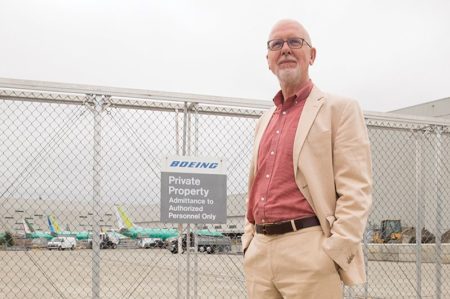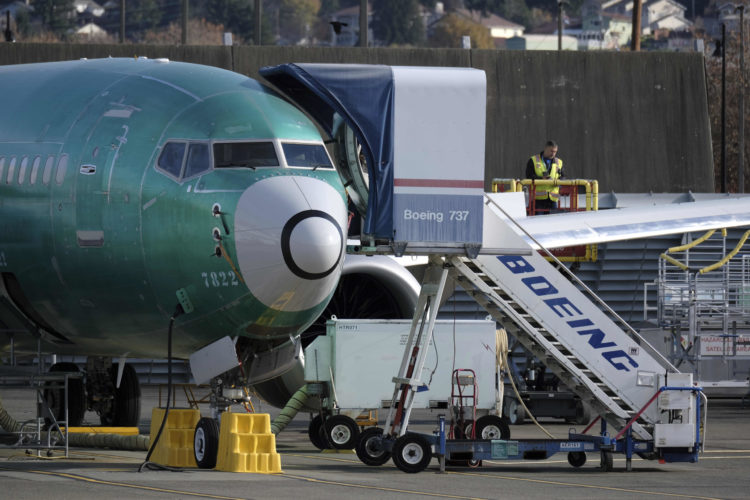As the aerospace beat reporter for the Seattle Times, Dominic Gates is one of the world’s most knowledgeable journalists about the business of commercial aviation, and especially about the Boeing Company, long based in Seattle and long the premier manufacturer of commercial aircraft. A former math teacher from Ireland, Gates landed the Times aviation beat in 2003; he’s since published hundreds of articles on the subject.
That knowledge came to bear after 346 people were killed in back-to-back crashes of Boeing 737 MAX airplanes, one in Indonesia in 2018 and another in Ethiopia in 2019. The 737 MAX was grounded as the Federal Aviation Administration (FAA) launched an investigation into possible mechanical and oversight failures that may have led to the crashes. At the same time, Gates launched his own investigation.

The resulting work by Gates and three colleagues at the Times won the 2020 Pulitzer Prize in National Reporting. (Editor's note: There were two Pulitzers in national reporting awarded that year, the other to a team from Pro Publica that investigated a series of deadly naval accidents.)
The work also caught the attention of other media. Gates has been featured in or interviewed by several other news outlets. Most recently, he was both a key source and main character in the documentary “Flight/Risk” (2022) about the lead-up to and aftermath of the fatal crashes.
As a documentary filmmaker, I was curious about the experience of a straightforward print beat reporter who is tapped as both source and subject of a film told along a more narrative arc. What did Gates make of the challenges and possible advantages of the two nonfiction forms? Our conversation has been lightly edited for length and clarity.
When you were initially invited to participate in “Flight/Risk,” how did the team behind the film pitch it?
In January 2020, I got pitches to be part of three different documentaries. The “Flight/Risk” pitch sold me because, as they essentially said, “We don't want a TV-style documentary. We want storytelling that's more like a movie. We want characters. You're not going to be sitting down with a bookcase behind you.” I was also sold on the people who pitched me. I was wary at the beginning because one thinks of Hollywood-types as not being very trustworthy, but these weren't Hollywood-style stereotypes at all. They were much more earnest, interested in the content of what they were doing. I really bonded with the main director, Omar Mullick, a British guy of Afghan descent. He and I shared a working class upbringing, outsider status growing up (me a Catholic in Northern Ireland and him a dark-skinned Muslim in England) and a life lifted higher through education.
I've been part of six other TV documentaries about the MAX crashes where I was exactly that — a talking head. It just seemed a lot more interesting to do something that would be more gripping to a bigger audience.
What was involved in the filming of “Flight/Risk?”
It was pretty easy. Early in the process, I took some days off from the newspaper to film with them in 2020 and 2021. They’d come and ask me questions and they’d sometimes film me sitting around a table showing them documents. Later they wanted scenes of me working, but I was apprehensive because I didn’t want to have to act. They said, “You’re not going to be acting, pretending or doing something fake. We’ll film you doing what you do. We'll talk to you and ask questions and you can answer them, but when we film you doing things, it'll be real.”
I was also a consultant on the film. They had many different people in the movie, but I knew most about the overall story and what caused the crashes. So I helped them contact other people, including some of my sources who agreed to talk to them.
At one point, they asked whether one of my sources wanted to be in the movie. That was a problem because the sources we’re talking about are very confidential. At first, I said they couldn’t film me meeting that source because the cameras would draw attention. So, one of the directors scouted around Seattle and said he’d found the perfect place: a downtown parking garage that was empty in the upper levels during the pandemic. It was discreet enough that they could film me meeting my source in person without drawing attention. The resonance with the Watergate story is obvious now, but the the views offered a sense of place that was great for the scene.
Before that, when the COVID lockdown was new, they asked if my two college-age daughters could help with filming. They sent us a high-end iPhone, tripod and all sorts of equipment. They asked my daughters to film me doing different things and interview me, although the only piece of that footage that made it into the movie was in the credit scene where you see me reacting to winning the Pulitzer.
As a behind-the-notebook beat reporter, how did you handle being both source and subject in the film?
I went with the flow, but I did draw some lines. For example, they wanted to film me in the bathroom shaving, then putting on my shirt and suit. After seeing the film, it made sense why they wanted it, but in that moment I just thought it was ridiculous to be filmed shaving, so I said no.
What did you learn by being part of this film that you might take back to your own beat work?
In terms of the story, what I reported in print was much more detailed than the story they managed to tell. They didn't go into the technicalities very much at all, which is perfectly understandable. I was perfectly happy with the portrayal of me and my work. However, the film also tells these other stories and one of them in particular is problematic for me, which is the story of Ed Pierson, the whistleblower.
Ed is a really good guy. He's got great integrity. And what Ed testified about —what he says in the movie about what was happening in the factory in the summer of 2018 before the first crash — is totally true. In fact, I wrote about it at the time, and there's a shot in the movie of my front page from that summer. But, what happened in the factory then didn't cause the 2018 crashes, and some could infer that the movie suggests otherwise.
Ed has continued to campaign that the MAX is still unsafe. He compiled a dossier of in-flight incidents reported by pilots of the MAX’s service. He sent that dossier to me and other journalists and none of us wrote about it. I investigated and concluded that the incidents were not safety incidents. They were routine. So unlike Ed, I don't believe the MAX is unsafe. Boeing has since fixed the MCAS (an inflight computerized maneuvering system). But saying that doesn't detract one iota from Boeing's responsibility for the crashes.
The chief thing I really regret is right at the end of the movie. A line appears just before the credits that says something like, “The MAX continues to have inflight incidents since it returned to service.” That's a direct reference to Pierson's dossier but, like I said, I don't agree that those incidents are significant safety issues.
I saw the film close to the final cut and they asked me for feedback. I told them that there was not enough emphasis on telling the viewers about MCAS and the engineering flaws and that that’s what caused the crashes. And there was too much emphasis on Ed Pierson's concerns about the factory which, although real, were not related to the crashes.
I like the movie. I think it will help spread the word of what happened here to a much bigger audience. But I do regret that many people, especially those who haven't followed all the details of previous news coverage, will look at the movie and will come away with the impression that what I talked about (the engineering flaws) and what Ed Pierson talked about (the factory flaws) are all of the same piece, and they’re not. To give people the impression that these two different aspects contributed equally to the crashes is, in my mind, false. So I wish that had been a bit different, but of course I didn’t control anything in the movie except the parts I was in.
After your feedback on the final cut, did you see any significant changes in the film?
They said they went through a lot of footage. They spent a lot of time looking for ways to amend the film, but they were very close to the end at that point. They just couldn't find something that fit in without destroying the narrative. In the end, the final product wasn't significantly changed.
Having been part of this film, what do you think is better captured in print versus film or vice versa?
You can provide much more detail in print. I don’t mean to be disparaging of film as a medium, and I think the filmmakers in this documentary provided deep emotional truth. In print, the Seattles Times news stories on the MAX crashes, one following another, scoop after scoop, over the course of a year, provided a level of detail that a movie couldn't cover.
In a documentary, you can't tell every story; you have to pick. The stories picked for the film were told at a top level of detail appropriate to the medium. What a movie can offer is emotional vividness. I think the filmmakers captured the story wonderfully through the people they chose to tell it. I'm proud to have worked with them. I admire what they did and the skill and passion with which they did it.
On the other hand, a movie can also be unfair to some of the people because it’s a simplified snapshot.
For example, in the movie, Steve Dickson, the FAA administrator, comes across terribly. In his testimony in Congress, which is what they filmed, he was off and the senators grilling him were grandstanding. I felt sorry for him afterwards because Dickson was appointed FAA administrator after the second crash. He was called in to try and fix it and he did move the FAA in a direction towards safety. He was also responsible for the CEO of Boeing, Dennis Muilenburg, being fired. Muilenburg kept saying, “The FAA is going to approve us within the next month,” except he said that repeatedly and it never happened. Eventually, in December of 2019, Dickson called him into his office and told him that he was taking one of the statements as pressure on the FAA and it had to stop. Dickson then issued a press release telling everybody that he had given Muilenburg a dressing down. The board fired Muilenburg a week later because it had become totally clear by Dickson's action that Muilenburg had lost the confidence of the FAA regulator. Dickson didn’t come out looking well in the film, but in the background Dickson actually did a very difficult job reasonably well. Since the crashes, the FAA has begun to hold Boeing's feet to the fire.
What I'm getting at is that every one of the characters in a real-life movie is more complex than it's possible to portray in 90 minutes.
***
Kristen Chin studied filmmaking at Boston University and now works as a documentary filmmaker and writer.



